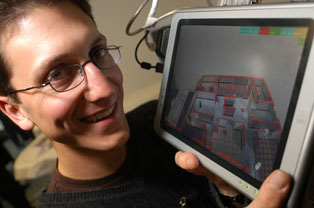Anyone who has struggled to find the on-off switch on the computer will appreciate a new technology being developed by researchers at the Department of Engineering.

In future you will be able to point your mobile phone camera at the offending piece of equipment and a computer-generated arrow will indicate where the elusive button is located. The same goes for the water bottle in the car, the release catch for the bonnet, the toner cartridge in the printer and so on.
Dr Tom Drummond's work in Augmented Reality has a variety of applications as he explains: "Augmented reality is about taking computer graphics and interfaces away from the computer screen and into the real world. We do this by using a video camera and intercepting the video before it reaches the viewfinder. Computer generated graphics are then added to the video so that the user sees an image of the real world overlaid with context sensitive information. Put simply, this gives the end user the ability to indicate 'this one' to the computer."
Work by the researchers, will radically improve fault diagnosis and maintenance checks. Dr Drummond sees a future when the instruction manual is provided electronically for loading on to your computer, PDA or even mobile phone.
Picture: Holdsworth Associates For example, in one demonstration a faulty printer is viewed as a video image on a tablet computer and then overlaid with a computer generated graphic. By touching the real world image on the computer screen the user is taken through a series of checks to eliminate the problem.
Dr Drummond is talking to a number of organisations about how the technology can be used to enable collaboration between remote parties, for example to improve safety in stadiums by improving coordination of ground operations from a central control point. These are situations where both parties have a different view point and may have information about specific locations that at present would be difficult to communicate effectively.
Other exciting applications include the film and computer game industries, where virtual characters can be placed into a real scene. The team have developed a prototype which uses a computer game to illustrate some of the more advanced capabilities of their Augmented Reality system.
Dr Tom Drummond
The Machine Intelligence Laboratory
University of Cambridge, Department of Engineering, Trumpington Street, Cambridge CB2 1PZ
E-mail: twd20@eng.cam.ac.uk
Telephone: +44 1223 7 65960
Fax: +44 1223 3 32662

